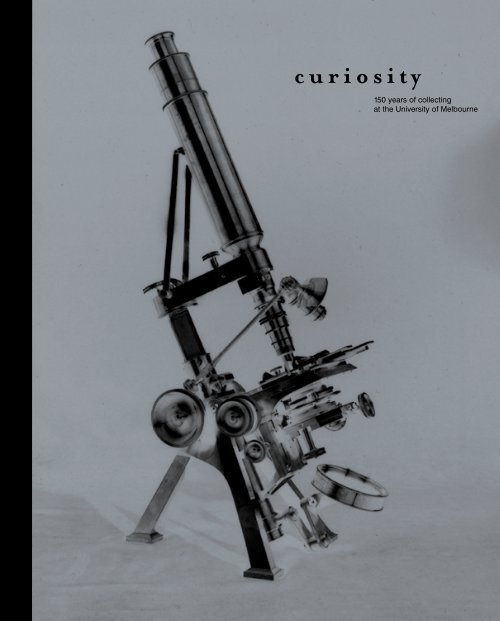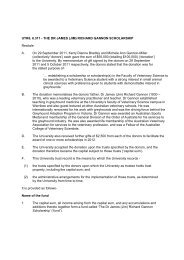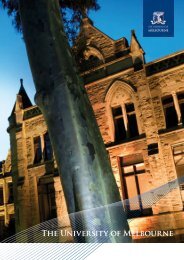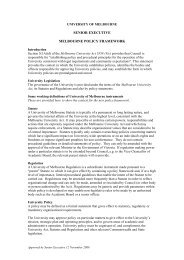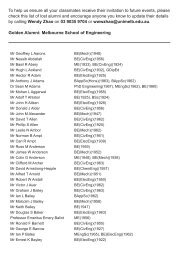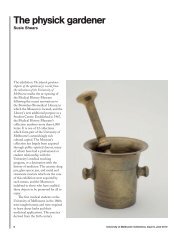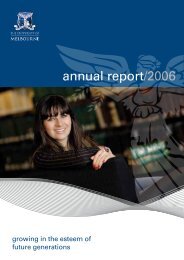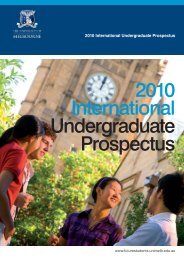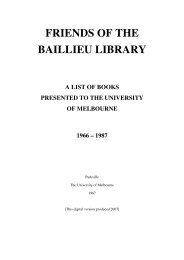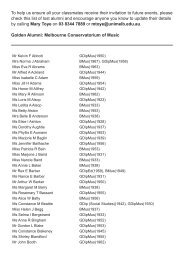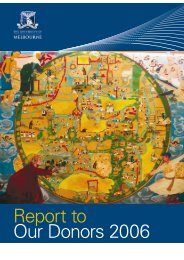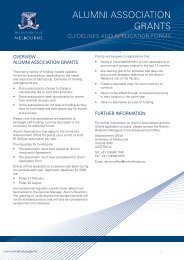Curiosity brochure 04 - University of Melbourne
Curiosity brochure 04 - University of Melbourne
Curiosity brochure 04 - University of Melbourne
Create successful ePaper yourself
Turn your PDF publications into a flip-book with our unique Google optimized e-Paper software.
curiosity<br />
150 years <strong>of</strong> collecting<br />
at the <strong>University</strong> <strong>of</strong> <strong>Melbourne</strong>
150 years <strong>of</strong> collecting<br />
at the <strong>University</strong> <strong>of</strong> <strong>Melbourne</strong><br />
curiosity<br />
cat. 83<br />
cat. 122<br />
In 1853 the Victorian Parliament passed the Act that established the<br />
<strong>University</strong> <strong>of</strong> <strong>Melbourne</strong>. To mark this sesquicentenary milestone in 2003<br />
the <strong>University</strong> has chosen two themes for its commemorative activities and<br />
publications: ‘a sense <strong>of</strong> history’ and ‘giving to students and the community’.<br />
<strong>Curiosity</strong>: 150 years <strong>of</strong> collecting at the <strong>University</strong> <strong>of</strong> <strong>Melbourne</strong> addresses both <strong>of</strong> these ideals.<br />
The exhibition includes a diverse selection <strong>of</strong> artefacts from a number <strong>of</strong> the <strong>University</strong>’s collections,<br />
ranging from the library, art collection and archives to medical, dental, engineering and scientific<br />
collections. The objects were accumulated across the entire history <strong>of</strong> the <strong>University</strong>, demonstrating<br />
how collections have been essential to the work <strong>of</strong> this institution since its very inception. We are<br />
fortunate today that staff, students and other interested individuals had the foresight to retain and<br />
document these artefacts for posterity.<br />
Many <strong>of</strong> the <strong>University</strong>’s collections are the result <strong>of</strong> remarkable generosity by philanthropic<br />
individuals. By donating or bequeathing to the <strong>University</strong> their <strong>of</strong>ten extensive personal holdings<br />
<strong>of</strong> literature, artworks and historical items, such benefactors have greatly enriched the <strong>University</strong> for<br />
future generations <strong>of</strong> students and staff, opening up new horizons and opportunities for learning and<br />
enjoyment. It is the <strong>University</strong>’s responsibility to fulfil the spirit <strong>of</strong> these gifts and bequests by caring<br />
for its ever-richer collection, and by making it accessible to the wider community through various<br />
means such as exhibitions, reading rooms, lending programs, publications, online catalogues and<br />
educational activities. The present exhibition is an example <strong>of</strong> this, providing the curious visitor with<br />
a glimpse into a number <strong>of</strong> the <strong>University</strong>’s holdings, and highlighting their variety, broad scope<br />
and richness.<br />
<strong>Curiosity</strong>: 150 years <strong>of</strong> collecting at the <strong>University</strong> <strong>of</strong> <strong>Melbourne</strong> is the result <strong>of</strong> collaboration<br />
between staff <strong>of</strong> the Ian Potter Museum <strong>of</strong> Art, the <strong>University</strong> <strong>of</strong> <strong>Melbourne</strong> Conservation Service<br />
and the custodians <strong>of</strong> collections in many departments <strong>of</strong> the <strong>University</strong>. Acknowledgment is due<br />
in particular to the staff and honorary custodians <strong>of</strong> the collections held by the Information Division;<br />
the Faculty <strong>of</strong> Medicine, Dentistry and Health Sciences; the Faculty <strong>of</strong> Science; the Faculty <strong>of</strong><br />
Engineering and the <strong>Melbourne</strong> Law School.<br />
1<br />
Pr<strong>of</strong>essor Alan D. Gilbert Vice-Chancellor, the <strong>University</strong> <strong>of</strong> <strong>Melbourne</strong>
<strong>Curiosity</strong>: the basis <strong>of</strong> all knowledge<br />
The collections owned by Australian universities form a significant<br />
part <strong>of</strong> our nation’s moveable cultural and scientific heritage. 1<br />
The <strong>University</strong> <strong>of</strong> <strong>Melbourne</strong>, an institution with a 150 year history,<br />
is typical <strong>of</strong> our nation’s older and larger educational institutions<br />
in this respect, being a custodian <strong>of</strong> varied collections that serve<br />
a range <strong>of</strong> purposes to students and staff and to the wider community.<br />
2<br />
Library collections are at the centre <strong>of</strong> university life as they<br />
are essential for teaching and research at all levels. Raymond<br />
Priestley (1886–1974), Vice-Chancellor from 1935 to 1938,<br />
saw a university’s library as sacred, ‘a place <strong>of</strong> pilgrimage’. 2<br />
On a more prosaic note, in the early days <strong>of</strong> the <strong>University</strong>,<br />
<strong>Melbourne</strong>’s geographic distance from the older centres<br />
<strong>of</strong> learning in Europe and the eastern United States would<br />
have rendered ready access to recent books and journals<br />
especially important in maintaining dialogue with other<br />
scholars and keeping up with the latest theories and<br />
discoveries. The first pr<strong>of</strong>essors appointed at <strong>Melbourne</strong>,<br />
however, were heavily dependent on their own personal<br />
libraries, as the <strong>University</strong>’s collection had a slow beginning.<br />
Indeed, the first full-time Librarian, rather than Assistant<br />
Librarian, was not appointed until 1892. 3 By 1871 the<br />
<strong>University</strong> spent more money annually on maintaining its<br />
grounds than on its library. 4 The central <strong>University</strong> Library<br />
was originally located in the <strong>University</strong>’s first building,<br />
the old Quadrangle, expanding at various times into different<br />
parts <strong>of</strong> that building until moving to its present home<br />
in the new Baillieu Library Building in 1958. In the meanwhile,<br />
various branch libraries had been established: by 1915 the<br />
medical, chemical engineering, geological, botanical and<br />
zoological library collections were each located in the<br />
corresponding schools. 5<br />
The development <strong>of</strong> the Baillieu Library’s Special Collections,<br />
like so many other collections <strong>of</strong> the <strong>University</strong>, has benefited<br />
significantly from the generosity <strong>of</strong> private benefactors.<br />
Among the most notable gifts and bequests are the collection<br />
<strong>of</strong> George McArthur (1842–1903) which significantly increased<br />
the size and quality <strong>of</strong> the collection, the progressive<br />
donation from 1959 by Dr John Orde Poynton (1906–2001)<br />
<strong>of</strong> thousands <strong>of</strong> rare books and prints, later followed by the<br />
generous bequest <strong>of</strong> Sir Russell Grimwade (1879–1955)<br />
and Lady (Mabel) Grimwade (1887–1973). The Grimwades’<br />
contributions to the <strong>University</strong> included not only their rare<br />
books, archival and art collections, but their Toorak home<br />
‘Miegunyah’ and a substantial monetary endowment.<br />
A very different type <strong>of</strong> donor was Percy Grainger<br />
(1882–1961), expatriate Australian composer, virtuoso pianist,<br />
conductor and folklorist. His motives in establishing the<br />
Grainger Museum in the 1930s were a mixture <strong>of</strong> deeply-felt<br />
concern to preserve and promote the study <strong>of</strong> the musics <strong>of</strong> a<br />
wide range <strong>of</strong> cultures including those <strong>of</strong> Asia and the Pacific,<br />
with a desire to memorialise his own life and achievements.<br />
Grainger never studied formally at this or any other university<br />
but held a lifelong affection for his birth town <strong>of</strong> <strong>Melbourne</strong><br />
and established this autobiographical archive and broader<br />
music collection at his own expense.<br />
Students, as such, are rarely memorialised through gifts<br />
to universities; only when they become notable alumni<br />
are they commemorated in this way. One exception however<br />
is the Classics and Archaeology Collection, which was<br />
assisted substantially in 1926 by a memorial gift <strong>of</strong> £500 from<br />
the parents <strong>of</strong> John Hugh Sutton (1906–1925), a remarkably<br />
talented classics student who died tragically young in a<br />
motorcycle accident. This collection enjoyed a second period<br />
<strong>of</strong> development from 1970 under the careful guidance <strong>of</strong> its<br />
curator the late Peter Connor. 6 The general paucity <strong>of</strong> classical<br />
archaeological collections in Australia means that its university<br />
collections in this field are <strong>of</strong> particular significance for<br />
researchers and to the community as a whole. 7<br />
The daily activity <strong>of</strong> the <strong>University</strong> generates its own material<br />
record, which must be preserved, both for reasons <strong>of</strong> legal<br />
obligation and for the interests <strong>of</strong> future researchers. The<br />
<strong>University</strong> <strong>of</strong> <strong>Melbourne</strong> Archives plays an important role here.<br />
Although formally established in 1960, its holdings date back<br />
to the inception <strong>of</strong> the <strong>University</strong>; they include not only the<br />
<strong>of</strong>ficial documents <strong>of</strong> the <strong>University</strong> such as Council minutes<br />
and student records, but also the personal papers <strong>of</strong> many<br />
graduates and former staff. From the 1970s the collecting<br />
fields expanded to include trade union and labour history, as<br />
well as the archives <strong>of</strong> businesses such as wholesalers and<br />
retailers, factories, law firms, architects, pastoral and mining<br />
companies, and <strong>of</strong> community, pr<strong>of</strong>essional, women’s, peace<br />
and political organisations. The Archives’ enormous holdings<br />
now extend to over 14 kilometres <strong>of</strong> shelf space. 8<br />
In contrast to the formal record-keeping function <strong>of</strong> the<br />
Archives, some other <strong>University</strong> collections were created<br />
or donated for a less tangible benefit—to ‘improve’ students’<br />
taste, morals, refinement or national sentiment—or simply<br />
to provide enjoyment and raise the quality <strong>of</strong> campus life. In<br />
donating his collection <strong>of</strong> mainly Australian art to the student<br />
union in 1938, the <strong>Melbourne</strong> surgeon and <strong>University</strong> alumnus<br />
Dr Samuel Arthur Ewing (1864–1941), hoped ‘that our youth<br />
may be inspired with the beauty as well as a deeper love<br />
<strong>of</strong> their country by the works <strong>of</strong> our artists’. 9 In the mid-1930s<br />
Arthur J. Law (1885–1973), Vice-Principal and later Principal<br />
<strong>of</strong> the <strong>Melbourne</strong> Teachers College, established a collection<br />
<strong>of</strong> Australian art, which now bears his name, for the benefit
<strong>of</strong> the teachers in training. Law aimed ‘to raise student<br />
standards <strong>of</strong> appreciation <strong>of</strong> art, literature and music. I felt that<br />
lectures were not sufficient. In art, students should have daily<br />
contact with original works.’ 10 Renowned for his old-fashioned,<br />
strict style <strong>of</strong> governance, Law imposed a five-shilling annual<br />
levy on students to help fund these acquisitions. 11 When<br />
the College amalgamated with the <strong>University</strong> in 1990 the<br />
collection became part <strong>of</strong> the larger <strong>University</strong> <strong>of</strong> <strong>Melbourne</strong><br />
Art Collection but is still displayed primarily in the College’s<br />
original 1888 Building on Grattan Street.<br />
Other collections served the purpose <strong>of</strong> educating students<br />
about different cultures and ways <strong>of</strong> life. The distinguished<br />
German-born ethnologist, jurist, Sinologist and author<br />
Dr Leonhard Adam (1891–1960), who in 1942 was appointed<br />
Reader in Anthropology in the Department <strong>of</strong> History,<br />
assembled a substantial collection <strong>of</strong> international indigenous<br />
cultural artefacts on behalf <strong>of</strong> the <strong>University</strong>. Adam aimed to<br />
build a collection for use in teaching and researching cultural<br />
anthropology and ethnology. Through field collecting,<br />
purchase, donation and exchange he modelled his collection<br />
on museums such as the Pitt Rivers at Oxford and the<br />
Peabody Museums at Harvard and Yale, attempting to<br />
assemble a ‘universal’ representation <strong>of</strong> ethnographic<br />
material. 12 Today this collection has a further potential function<br />
very different from that envisaged by its creator: research<br />
by indigenous people seeking to reconnect with their cultural<br />
traditions which have been disrupted or destroyed<br />
by colonisation.<br />
Many university collections were created for teaching complex<br />
scientific and technical disciplines to pr<strong>of</strong>essionals-in-training,<br />
such as doctors, dentists, surveyors, botanists, zoologists<br />
and geologists. Frequently these collections serve as<br />
reference examples <strong>of</strong> known types––whether <strong>of</strong> plants,<br />
minerals or animal skeletons––against which students learn<br />
to identify material they find in the field or in the course <strong>of</strong> their<br />
studies. The <strong>University</strong> <strong>of</strong> <strong>Melbourne</strong> Herbarium, for example,<br />
contains some 80,000 specimens, the earliest dating back<br />
to 1770, and covers all the major plant groups, although<br />
focussing on the flora <strong>of</strong> Victoria. Documentation and orderly<br />
storage are therefore <strong>of</strong> prime importance if such collections<br />
are to serve this reference purpose. Each herbarium sample<br />
must be carefully dried, mounted, labelled and catalogued.<br />
Examples <strong>of</strong> dried fungi, pressed flowers and algae in<br />
the exhibition demonstrate the meticulous nature <strong>of</strong> caring<br />
for such collections.<br />
Large taxonomic collections may no longer hold the central<br />
research role in some <strong>of</strong> the sciences which they held in<br />
earlier centuries, when classification was based principally<br />
on morphology. More recent techniques such as DNA<br />
analysis have changed our uses and understanding <strong>of</strong> such<br />
collections, as well as the techniques used for preservation,<br />
but many <strong>of</strong> the artefacts are still used for teaching and some<br />
have acquired new significances. One <strong>of</strong> the most spectacular<br />
objects in <strong>Curiosity</strong>: 150 years <strong>of</strong> collecting at the <strong>University</strong><br />
<strong>of</strong> <strong>Melbourne</strong> is the three-metre tall skeleton <strong>of</strong> the Moa,<br />
an extinct, flightless bird from New Zealand. Moa were the<br />
tallest birds ever known but had disappeared by the time<br />
Europeans colonised New Zealand. This skeleton, probably<br />
preserved by being embedded in a peat bog, was donated<br />
to the <strong>University</strong> by an eminent surgeon and <strong>University</strong> <strong>of</strong><br />
<strong>Melbourne</strong> alumnus, Dr George Armstrong (d. 1954). Because<br />
<strong>of</strong> its great height the skeleton is not usually displayed in its<br />
home in the Department <strong>of</strong> Zoology.<br />
Some academic disciplines require artificial models for<br />
teaching. While contemporary pedagogic methods have in<br />
some cases moved beyond these tools, the surviving<br />
examples are <strong>of</strong>ten <strong>of</strong> historical significance in their own right.<br />
The collection <strong>of</strong> the Department <strong>of</strong> Anatomy and Cell Biology<br />
for example contains some remarkable waxwork models<br />
<strong>of</strong> portions <strong>of</strong> the human body, the skin absent to reveal the<br />
underlying structure <strong>of</strong> blood vessels, muscles, nerves and<br />
tendons. These were made in the nineteenth century by<br />
the French firm <strong>of</strong> Tramond, located not far from the Paris<br />
<strong>University</strong>’s medical school. Beautifully crafted with great<br />
attention to detail <strong>of</strong> structure and colour, they demonstrate<br />
a more scholarly side <strong>of</strong> the famous French waxwork tradition,<br />
which also generated sensationally life-like models used<br />
for entertainment and spectacle in venues such Madame<br />
Tussaud’s in London.<br />
As an academic or technical discipline evolves over time,<br />
the tools <strong>of</strong> its practitioners can become obsolete as new<br />
technology is developed. If preserved these items form<br />
a material record <strong>of</strong> the history <strong>of</strong> that discipline. The<br />
fascinating collection <strong>of</strong> the Medical History Museum tells us<br />
not only about changes in medical understanding and patient<br />
care, but also about our attitudes to the body and mind,<br />
the role and status <strong>of</strong> the health practitioner in society, and<br />
the history <strong>of</strong> the medical pr<strong>of</strong>ession and medical education<br />
in Victoria. This tangible record vividly illustrates the ongoing<br />
continuum <strong>of</strong> medical discovery, and helps position the<br />
modern medical student or patient in that flow. 13 It can also<br />
highlight the misguided faith we sometimes place in untested<br />
technologies and theories. An artefact such as a plaster death<br />
mask <strong>of</strong> Ned Kelly (1854–1880), made after the bushranger<br />
was hanged at the <strong>Melbourne</strong> Gaol and now in the collection<br />
<strong>of</strong> the Department <strong>of</strong> Anatomy and Cell Biology, illustrates<br />
fundamental philosophical changes in the fields <strong>of</strong> anatomy,<br />
criminology and psychology. These death masks were<br />
used in the now discredited pseudo-science <strong>of</strong> phrenology,<br />
the analysis <strong>of</strong> character based on the contours <strong>of</strong> the<br />
human head.<br />
<strong>Curiosity</strong>: 150 years <strong>of</strong> collecting at the <strong>University</strong> <strong>of</strong> <strong>Melbourne</strong><br />
aims to show the diverse nature and purpose <strong>of</strong> the<br />
collections accumulated throughout the history <strong>of</strong> the<br />
institution. Over time, development and discovery in all the<br />
disciplines studied at the <strong>University</strong> <strong>of</strong> <strong>Melbourne</strong> will continue<br />
to bring new, possibly unexpected, meanings to its<br />
collections. Preserving, documenting and exhibiting these<br />
irreplaceable artefacts ensures that future students can<br />
continue to learn from them and that they will be relevant to<br />
the broader society. Unusual items will always stimulate<br />
curiosity in both the dedicated scholar and the casual viewer,<br />
and in the words <strong>of</strong> that most generous benefactor, Sir Russell<br />
Grimwade, curiosity is ‘the basis <strong>of</strong> all knowledge’. 14<br />
Belinda Nemec<br />
Collections Manager, the Ian Potter Museum <strong>of</strong> Art<br />
3
cat. 110 (detail)<br />
cat. 49<br />
cat. 38<br />
1 <strong>University</strong> Museums Review Committee, Cinderella collections:<br />
university museums and collections in Australia, Australian Vice-Chancellors’<br />
Committee, Canberra, 1996.<br />
2 John Poynter and Carolyn Rasmussen, A place apart: the <strong>University</strong> <strong>of</strong> <strong>Melbourne</strong>:<br />
decades <strong>of</strong> challenge, <strong>Melbourne</strong> <strong>University</strong> Press, 1996, p. 18.<br />
3 Ernest Scott, A history <strong>of</strong> the <strong>University</strong> <strong>of</strong> <strong>Melbourne</strong>, <strong>Melbourne</strong> <strong>University</strong> Press,<br />
1936, pp. 136–137.<br />
4 Ge<strong>of</strong>frey Blainey, A centenary history <strong>of</strong> the <strong>University</strong> <strong>of</strong> <strong>Melbourne</strong>, <strong>Melbourne</strong><br />
<strong>University</strong> Press, 1957, pp. 36–37.<br />
5 Susan Reidy et al, What a place for an education! 1853 to 2003 – the <strong>University</strong><br />
<strong>of</strong> <strong>Melbourne</strong> (exh. cat.), Baillieu Library, <strong>University</strong> <strong>of</strong> <strong>Melbourne</strong>, 2003, p. 8.<br />
6 John Burke, ‘Development <strong>of</strong> the collection’, in Peter Connor and Heather<br />
Jackson, A catalogue <strong>of</strong> Greek vases in the collection <strong>of</strong> the <strong>University</strong><br />
<strong>of</strong> <strong>Melbourne</strong> at the Ian Potter Museum <strong>of</strong> Art, Macmillan, 2000, p. 13.<br />
7 <strong>University</strong> Museums Review Committee, p. 53.<br />
8 The <strong>University</strong> <strong>of</strong> <strong>Melbourne</strong> Archives (<strong>brochure</strong>), The <strong>University</strong> <strong>of</strong> <strong>Melbourne</strong><br />
Archives, (n.d.), (n.p.).<br />
9 Commemorative plaque at the Ewing Gallery, reproduced in Catalogue<br />
<strong>of</strong> the Ewing Art Gallery: Union House, <strong>University</strong> <strong>of</strong> <strong>Melbourne</strong>,<br />
<strong>Melbourne</strong> <strong>University</strong> Press, 1938.<br />
10 F.C. Mellow, ‘The A.J. Law Art Collection’, in Trainee: the annual magazine<br />
<strong>of</strong> <strong>Melbourne</strong> Teachers College, anniversary issue, 1964, p. 95.<br />
11 Don Garden, The <strong>Melbourne</strong> teacher training colleges: from training<br />
institution to <strong>Melbourne</strong> State College 1870–1982, Heinemann, Richmond<br />
(Victoria) 1982, pp. 179–180.<br />
12 Robyn Sloggett, ‘I have now made a start’, in Bounty <strong>of</strong> the sea: the Leonhard<br />
Adam Collection <strong>of</strong> International Indigenous Culture (exh. cat.), Ian Potter Museum<br />
<strong>of</strong> Art, <strong>University</strong> <strong>of</strong> <strong>Melbourne</strong>, 2002, (n.p.).<br />
13 Ann Brothers, Significance assessment (The Medical History Museum, the<br />
<strong>University</strong> <strong>of</strong> <strong>Melbourne</strong>), unpublished report, October 2002, p. 11.<br />
14 Russell Grimwade, notes for public lecture ‘A nation’s treasures’, delivered<br />
on 13 September 1949, now held in the <strong>University</strong> <strong>of</strong> <strong>Melbourne</strong> Archives, quoted<br />
in Rachel Kent et al, Art, industry and science: the Grimwade legacy (exh. cat.),<br />
the <strong>University</strong> <strong>of</strong> <strong>Melbourne</strong> Museum <strong>of</strong> Art, (1997), p. 5.<br />
cat. 5<br />
cat. 103 (detail)<br />
4<br />
cat. 57
5<br />
Baillieu Library Print Collection<br />
1 Jacques Callot (1592–1635)<br />
The strappade (1633)<br />
etching; sheet 8.3 x 18.8 cm<br />
Gift <strong>of</strong> Dr J. Orde Poynton 1959. 1959.2123<br />
2 Jacques Callot (1592–1635)<br />
The wheel (1633)<br />
etching; sheet 8.3 x 18.6 cm<br />
Gift <strong>of</strong> Dr J. Orde Poynton 1959. 1959.2124<br />
3 Canaletto (Antonio da Canale, 1697–1768)<br />
Mestre (n.d.)<br />
etching, first state; plate 30.0 x 42.7 cm<br />
Gift <strong>of</strong> Dr J. Orde Poynton 1959. 1959.2128<br />
4 Rembrandt van Rijn (1606–1669)<br />
Landscape with a cottage and haybarn 1641<br />
etching; plate 12.9 x 31.5 cm<br />
Gift <strong>of</strong> Dr J. Orde Poynton 1959. 1959.3721<br />
5 Giandomenico Tiepolo (1727–18<strong>04</strong>)<br />
The Holy Family being ferried across the<br />
Nile in a boat (1753)<br />
etching; plate 17.6 x 23.5 cm<br />
Purchased 1994. 1994.2610<br />
Baillieu Library Special Collections<br />
6 Catalogue <strong>of</strong> the Library <strong>of</strong> the <strong>University</strong><br />
<strong>of</strong> <strong>Melbourne</strong>, Victoria<br />
J.J. Guillaume, Colonial Bookseller, London, 1856<br />
7 The catalogue <strong>of</strong> the <strong>Melbourne</strong> Public Library<br />
Designs by Edward La Trobe Bateman,<br />
engraved by Samuel Calver<br />
Printed by Clarson Shallard & Co., <strong>Melbourne</strong>, 1861<br />
8 Catalogue <strong>of</strong> books from the George McArthur bequest<br />
in Central Library & branches. Licelus to Z (1903?)<br />
manuscript<br />
9 A catalogue <strong>of</strong> the different specimens <strong>of</strong> cloth<br />
collected in the three voyages <strong>of</strong> Captain Cook to<br />
the Southern Hemisphere …<br />
Printed for Alexander Shaw, London, 1787<br />
Grimwade Collection<br />
10 William Caxton (1422–1491)<br />
The history <strong>of</strong> Reynard the foxe<br />
Kelmscott Press, London, 1892<br />
11 Various authors; art and design by Sian Marlow<br />
Six different ways 1997<br />
Merrijig Word & Sand Co. <strong>Melbourne</strong>, 1997<br />
Baillieu Library Special Collections:<br />
Morgan Collection <strong>of</strong> Children’s Literature<br />
12 Phoebe, the cottage maid: exemplified<br />
in a series <strong>of</strong> rural figures<br />
London, printed for S. and J. Fuller, 1811<br />
13 Kate Greenaway (1846–1901)<br />
Almanack for 1890<br />
G. Routledge, London & New York, 1889-1890<br />
14 Comic grammar<br />
(England, c. 1825)<br />
15 A history <strong>of</strong> flowers and The infant’s cabinet <strong>of</strong> flowers<br />
printed by J. Marshall, London, 1801<br />
16 Kate Greenaway (1846–1901)<br />
Kate Greenaway’s alphabet<br />
17 Ladies English costumes<br />
I. Royle, London, 1821<br />
Classics and Archaeology Collection<br />
18 Greek<br />
Figurine <strong>of</strong> standing youth (c. 450–425 BC)<br />
ceramic; 31.3 x 9.8 x 7.0 cm<br />
John Hugh Sutton Memorial Bequest. 1929.0010<br />
19 Attic /Italian(?) black-figure<br />
Bowl with floral band (c. 500–475 BC)<br />
ceramic; 7.0 x 20.0 x 14.2 cm<br />
Purchased 1980, Arts Faculty Equipment Fund<br />
1980.0208<br />
20 East Greek / Rhodes<br />
Ionian cup (570–550 BC)<br />
ceramic; 9.0 x 22.0 x 16.5 cm<br />
Purchased 1983, Arts Faculty Equipment Fund<br />
and Department <strong>of</strong> Classical Studies Funds<br />
1983.0105<br />
Dental Museum<br />
21 Amalgamated Dental Co. (London)<br />
Foot engine to operate dental drill,<br />
with Doriot-type hand piece (c. 1920s)<br />
cast iron, steel; 160.0 x 45.0 x 30.0 cm. Reg. no. 516<br />
22 Myer, and Wood & Sons (London)<br />
Dental extraction key (c. 1800–1850)<br />
metal, ivory; 3.0 x 9.5 x 15.5 cm. Reg. no. 653<br />
23 Crescent Dental Manufacturing Co. (New York)<br />
Amalgam balance with adjustable beam<br />
suspension (c. 1935)<br />
bakelite, brass; 4.0 x 16.0 x 6.0 cm<br />
Gift <strong>of</strong> a Collins Street dentist. Reg. no. 695<br />
24 Claudius Ash Sons and Co. (London)<br />
Pestle and mortar (1900)<br />
stone; 7.0 x 9.0 cm. Reg. no. 687<br />
25 Unknown<br />
Timer (c. 1890)<br />
glass, boxwood, sand; 8.0 x 4.0 cm. Reg. no. 675<br />
26 Dr C.N. Johnson (Chicago)<br />
Teaching model, set <strong>of</strong> five teeth with prepared<br />
cavities to receive gold inlays 1912<br />
human teeth, wood, blue inlay wax<br />
5.5. x 9.0 x 23.0 cm<br />
Gift <strong>of</strong> Dr John Iliffe. Reg. no. 600<br />
27 Prisma, agents for Amalgamated Dental Co.<br />
(London and Holland)<br />
Porcelain outfit (c. 1935)<br />
wood, velvet, glass, porcelain; 6.0 x 36.0 x 26.0 cm<br />
Reg. no. 277<br />
28 Dental ceramics part III: porcelain jacket crowns<br />
The Amalgamated Dental Co. Ltd, London, 1935<br />
Reg. no. 1277/B<br />
29 Unknown<br />
Single point rose head drill (c. 1790)<br />
metal, ivory; 12.0 x 0.8 cm. Reg. no. 297<br />
30 Unknown (London)<br />
Single-handed ratchet operated drill with<br />
spring return arm (c. 1850)<br />
steel, ebonite; 23.0 x 7.0 cm. Reg. no. 305<br />
31 Dental Manufacturing Co. (London)<br />
Right or contra angle hand piece (c. 1900)<br />
steel, ebonite; 15.5 x 1.5 x 1.0 cm. Reg. no. 303<br />
32 Amalgamated Dental Co. (London)<br />
Straight hand piece for use with foot and<br />
electric dental engines (1940s)<br />
nickel plated steel; 14.0 x 1.0 cm<br />
From the teaching clinics <strong>of</strong> the Dental School.<br />
Reg. no. 334<br />
33 Morita (Japan)<br />
Air bearing contra angle hand piece (1990)<br />
steel alloy; 11.0 x 1.0 x 1.0 cm<br />
From the teaching clinics <strong>of</strong> the Dental School<br />
Reg. no. 343<br />
34 Unknown (<strong>Melbourne</strong>)<br />
Two early artificial dentures (not a set) (19th century)<br />
hand-carved ivory bases, human or porcelain front teeth<br />
5.0 x 5.5 x 2.0 cm and 5.5. x 6.5 x 2.0 cm<br />
Reg. nos 260 and 237<br />
35 Unknown (England)<br />
Dentures (c. 1780)<br />
gold alloy plate base, human front teeth,<br />
carved bone back teeth; 5.0 x 6.0 x 4.5 cm. Reg. no. 266<br />
Department <strong>of</strong> Anatomy and Cell Biology<br />
36 Tramond (Paris)<br />
Educational model <strong>of</strong> human head and shoulders<br />
showing the heart and blood vessels (19th century)<br />
wax, bone, mixed media; approx. 50.0 x 40.0 x 20.0 cm<br />
37 Tramond (Paris)<br />
Educational model <strong>of</strong> human head and torso showing<br />
internal organs (19th century)<br />
wax, bone, calico, mixed media; length approx. 80.0 cm<br />
38 Maximillian Kreitmayer (<strong>Melbourne</strong>)<br />
Death mask <strong>of</strong> Edward ‘Ned’ Kelly (1880)<br />
plaster <strong>of</strong> Paris, paint; height approx. 30.0 cm<br />
Department <strong>of</strong> Geomatics<br />
39 Chesterman (Sheffield)<br />
Gunter’s chain (late 19th century)<br />
brass, iron; length approx 20.1 metres<br />
40 Artificial horizon with bottle to hold mercury<br />
(late 19th century)<br />
metal, glass, wood, bone<br />
bottle height 10.5 cm; cover height 10.8 cm<br />
41 Ulysse Nardin (Switzerland)<br />
Sidereal time chronometer 1955<br />
wood, metal, leather, glass; 24.0 x 32.0 x 26.0 cm<br />
Electrical Engineering Education<br />
Museum, Department <strong>of</strong> Electrical<br />
and Electronic Engineering<br />
42 Elliot Bros (London)<br />
Kelvin galvanometer (1896)<br />
brass, metal, glass; 51.0 x 21.0 x 21.0 cm<br />
Reg. no. 44<br />
Ernst Matthaei Memorial Collection<br />
<strong>of</strong> Early Glass<br />
43 Unknown (England)<br />
Large rummer or punch bowl (c. 1830)<br />
glass; height 17.2 cm<br />
Purchased with funds from the Ernst Matthaei Memorial<br />
Bequest 1984. 1984.0226 (no.180)<br />
44 William Beilby (engraver, 1740–1819)<br />
Wine glass (c. 1765)<br />
glass; height 14.7 cm<br />
Purchased with funds from the Ernst Matthaei Memorial<br />
Bequest 1985. 1985.0011 (no.183)<br />
45 Unknown (England)<br />
Goblet (c. 1700)<br />
glass; height 22.7 cm<br />
Purchased with funds from the Ernst Matthaei Memorial<br />
Bequest 1989. 1989.0071 (no.45)<br />
46 Unknown (England)<br />
Toasting glass (c. 1750)<br />
glass; height 18.7 cm<br />
Gift <strong>of</strong> Mrs Joyce Meldrum 1996. 1996.0023 (no.240)<br />
Grainger Museum<br />
47 Rupert Bunny (1864–1947)<br />
Percy Grainger (c. 1902–<strong>04</strong>)<br />
oil on canvas; 99.2 x 83.6 cm<br />
48 Tom Roberts (1856–1931)<br />
Pr<strong>of</strong>essor G.W.L. Marshall-Hall 1900<br />
oil on canvas; 53.5 x 43.8 cm<br />
Purchased by Percy Grainger from Hubert Marshall Hall 1937<br />
49 Ella Grainger née Ström (1889–1979)<br />
Towelling costume: shorts, leggings, waistcoat,<br />
shirt and shoes (c. 1934)<br />
Dri-Glo cotton bath towels, bath mat, leather<br />
Gift <strong>of</strong> Percy Grainger<br />
50 Percy Grainger (1881–1962)<br />
The warriors: music for an imaginary ballet 1916<br />
full orchestral score manuscript<br />
Lodged by Percy Grainger in the Grainger Museum<br />
51 Edvard Grieg (1843–1907)<br />
Letter to Percy Grainger 30 June 1906<br />
52 Pytor Ilyich Tchaikovsky (1840–1893)<br />
Letter to Maurice Ernst 15 June 1893<br />
53 Thomas Hardy (1840–1928)<br />
Letter to Henry Balfour Gardiner 21 January 19<strong>04</strong><br />
54 Lange & Sohne (Glashütte, Saxony).<br />
Pocket watch (c. 1893)<br />
gold, unidentified metal, glass, velvet, leather<br />
diameter 5.5 cm<br />
55 Kilpatrick & Co. (London and <strong>Melbourne</strong>)<br />
Conducting baton 1880<br />
ivory or bone, silver, gold, leather, velvet; length: 57.3 cm<br />
Law Rare Books Collection,<br />
Legal Resource Centre<br />
56 Statutes at large vol. 6, 3 Geo. 2–20 Geo. 2,<br />
printed for Mark Basket by Robert Basket, Henry Woodfall<br />
and William Strahan, London, 1769<br />
Leonhard Adam Collection<br />
<strong>of</strong> International Indigenous Culture<br />
57 Kwakwaka’Wakw (Canada)<br />
Bird mask (c. 1900–1960)<br />
red cedar, red cedar bark, paint; 25.0 x 121.0 x 28.0 cm<br />
Acquired by exchange with the <strong>University</strong> <strong>of</strong> British Columbia<br />
Museum <strong>of</strong> Anthropology, 1957. 1960.0558<br />
58 Yirritja (Arnhem Land)<br />
Canoe model (n.d.)<br />
wood, pigment (ochres and clay); 11.4 x 48.4 cm<br />
1960.1226<br />
59 Marind-Anim (Digul River region, West Papua)<br />
Drum with stylized crocodile and animal motifs (n.d.)<br />
wood, cassowary feathers, textile, pigment; 75.5 x 18.0 cm<br />
Gift <strong>of</strong> Mr C.E. Howlett 1952. 1960.1460
Medical History Museum<br />
60 Unknown (Deruta, Italy)<br />
Spouted wet-drug pot inscribed “AQa D Fior.<br />
D. SANBUCo’. (c. 1670)<br />
earthenware (maiolica); height 25.0 cm<br />
Graham Roseby Collection, permanent loan. Reg. no. L.20<br />
61 Palmer’s Products<br />
Printing block for Palmer’s Australian Magic Mixture<br />
(late 19th century)<br />
wood, metal; 4.5 x 2.5 x 5.5. cm<br />
Gift <strong>of</strong> Dr J. Orde Poynton. Reg. no. 2688.4<br />
62 Palmer’s Products<br />
Printing block for Palmer’s Carrageen (Irish Moss)<br />
cough mixture (late 19th century)<br />
wood, metal; 17.0 x 6.0 x 2.5 cm<br />
Gift <strong>of</strong> Dr J. Orde Poynton. Reg. no. 2688.1<br />
63 Palmer’s Products<br />
Packaging for Palmer’s dandelion and chamomile pills<br />
(late 19th century)<br />
paper; 6.5 x 3.0 x 2.5 cm<br />
Gift <strong>of</strong> Dr J. Orde Poynton. Reg. no. 1877.1<br />
64 Palmer’s Products<br />
Packaging for Palmer’s neuralgic pills (late 19th century)<br />
paper; 6.5 x 3.0 x 2.5 cm<br />
Gift <strong>of</strong> Dr J. Orde Poynton. Reg. no. 1878.2<br />
65 Unknown<br />
Edward H. Poynton (c. 1870)<br />
hand-coloured ambrotype photograph in leather case<br />
case (closed); 23.3. x 18.0 x 2.0 cm. Reg. no. 3236<br />
66 Poulton and Owen, Homeopathic Chemists (<strong>Melbourne</strong>)<br />
Homeopathic medical chest (c. 1870s)<br />
contents by Martin and Pleasance, Homeopathic Chemists<br />
(<strong>Melbourne</strong>)<br />
wood, cardboard, paper, cork, leather, glass, brass<br />
20.0 x 28.7 x 21.5 cm. Reg. no. 2189<br />
67 Joseph Gray and Son (Sheffield)<br />
Valved cupping set (c. 1850s–1870s)<br />
8.5 x 18.5 x 13.0 cm; wood, glass, brass, velvet<br />
Gift <strong>of</strong> Dr W. Griffiths 1981. Reg. no. 194.1-.6<br />
68 L. Hunter (London)<br />
Scarifier (1840s)<br />
brass, steel; 7.0 x 6.0 x 5.0 cm. Reg. no.196.1<br />
69 Powell and Lealand (London)<br />
Compound monocular and binocular microscope<br />
(c. 1860)<br />
brass, silver, gilt, glass; height 46.2 cm<br />
Gift <strong>of</strong> the grand-daughter <strong>of</strong> Pr<strong>of</strong>essor G.B. Halford 1979<br />
Reg. no. 38.39<br />
70 G.B. Halford (1824–1910)<br />
Set <strong>of</strong> 18 microscope slides<br />
glass, biological specimens; each slide 7.5 x 2.5 cm<br />
71 Unknown<br />
The dissecting room 1864<br />
photograph; sight 23.5 x 28.5 cm. Reg. no. 463.1<br />
72 Unknown<br />
First women medical students,<br />
<strong>University</strong> <strong>of</strong> <strong>Melbourne</strong> 1887<br />
black and white photograph; 28.2 x 33.3 cm<br />
Reg. no. 2037.1<br />
Physics Museum<br />
73 Victor (Boston) and Macalaster Wiggin & Co.<br />
Gas type X-ray tube (late 19th century)<br />
glass, copper, tungsten, ceramic; 34.0 x 55.0 x 23.0 cm<br />
Rare Books Collection, Music Library<br />
74 Arcangelo Corelli (1653–1713)<br />
‘Sonata à tre, doi violini, e violone, ò arcileuto<br />
col basso per l’organo, opera terza’<br />
Gio. Giacomo Komarek, Rome, 1689<br />
75 Harriet Abrams (1760?–1821)<br />
‘Female hardship: a favorite song …’<br />
L. Lavenu & Mitchell, London (1802?)<br />
F.A. Singleton Museum,<br />
School <strong>of</strong> Earth Sciences<br />
76 Howard Davis (Boston)<br />
Gold bullion balance (c. 1850s)<br />
brass, steel, copper, wood, bone, glass<br />
90.0 x 110.0 x 46.0 cm<br />
77 Tray <strong>of</strong> mineral specimens<br />
(collected and purchased c.1935)<br />
geological specimens, wood, velvet, metal, plastic<br />
tray 5.0 x 47.0 x 45.5. cm<br />
Tiegs Museum, Department <strong>of</strong> Zoology<br />
78 Skeleton <strong>of</strong> Moa bird (Dinornis robustus)<br />
height approx. 330.0 cm<br />
Gift <strong>of</strong> Dr George Armstrong<br />
79 Mounted skin <strong>of</strong> echidna (Tachyglossus aculeatus)<br />
15.0 x 30.0 x 20.0 cm<br />
80 Skull <strong>of</strong> Thylacinus cynocephalus<br />
15.0 x 25.0 x 10.0 cm<br />
81 Foot <strong>of</strong> kangaroo (Macropus sp.)<br />
70.0 x 30.0 x 20.0 cm<br />
<strong>University</strong> <strong>of</strong> <strong>Melbourne</strong> Archives<br />
82 A.C. Smart<br />
Untitled (Interior <strong>of</strong> the original Wilson Hall,<br />
the <strong>University</strong> <strong>of</strong> <strong>Melbourne</strong>) (1878)<br />
watercolour<br />
sheet: 82.0 x 61.0 cm; comp. 65.8 x 44.5 cm<br />
Bates Smart & McCutcheon Collection<br />
83 Member(s) <strong>of</strong> the United Tinsmiths, Ironworkers and<br />
Japanners’ Society <strong>of</strong> Victoria<br />
Ceremonial suit <strong>of</strong> armour (c. 1880s)<br />
metal, feathers; breast plate: 53.0 x 65.0 cm<br />
Metalworkers Union Collection, transferred to the<br />
<strong>University</strong> <strong>of</strong> <strong>Melbourne</strong> Archives by the Victorian<br />
Trades Hall Council, 1978<br />
84 Laurence J. Hartnett (1898–1986)<br />
Car prototype model c. 1948<br />
metal, rubber, paint; approx. 38.0 x 86.0 x 38.0 cm<br />
85 Unknown<br />
Women’s Hockey Team, <strong>University</strong> <strong>of</strong> <strong>Melbourne</strong><br />
(c. 1909–1911)<br />
black and white photograph<br />
24.2 x 30.0 cm. UMA/I/2145<br />
86 Lafayette-Sarony (<strong>Melbourne</strong>)<br />
<strong>Melbourne</strong> <strong>University</strong> Rugby Football Club 1931<br />
black and white photograph<br />
24.5 x 30.0 cm. UMA/I/1625<br />
87 Sears Studios (<strong>Melbourne</strong>)<br />
Women’s tennis team, <strong>University</strong> <strong>of</strong> <strong>Melbourne</strong> (n.d.)<br />
photograph; 24.8 x 30.0 cm<br />
UMA/I/1207<br />
88 <strong>Melbourne</strong> <strong>University</strong> Medical Students’ Society<br />
annual dinner menu 17 September 1914<br />
Papers <strong>of</strong> Medical Students’ Association. 93/17<br />
89 Getting the Bird 8 May 1939<br />
programme for seventh annual revue presented by<br />
the students <strong>of</strong> the <strong>University</strong> <strong>of</strong> <strong>Melbourne</strong>. 97/41<br />
90 Nobelstiftelsens Högtidsdag<br />
(Program from ceremony awarding Nobel prize to<br />
Sir Frank Mcfarlane Burnet, 10 December 1960). 89/34<br />
91 G. Liljestrand <strong>of</strong> Karolinska Institutets Nobelkommitté<br />
Letter to Pr<strong>of</strong>essor Sir Frank Macfarlane Burnet<br />
22 October 1960. 89/34<br />
92 Press cutting, Sun 21 October 1960<br />
‘Sir Macfarlane is joint Nobel Winner’. 89/34<br />
93 Farrago vol. 1, no. 1<br />
<strong>University</strong> <strong>of</strong> <strong>Melbourne</strong> Students Representative<br />
Council, 3 April 1925<br />
Papers <strong>of</strong> Samuel Pond. 83/27<br />
94 Proceedings on the occasion <strong>of</strong> the inauguration<br />
<strong>of</strong> the <strong>University</strong> <strong>of</strong> <strong>Melbourne</strong> 13 April 1855. 93/176<br />
95 Unknown<br />
Marcham the bellringer (c. 1890–1910)<br />
photograph; 13.5 x 8.8 cm. UMA/I/1155<br />
96 Unknown<br />
Optical Munitions, <strong>University</strong> <strong>of</strong> <strong>Melbourne</strong> (1940–1942)<br />
black and white photograph; 20.8 x 16.2 cm<br />
UMA/I/1472<br />
97 Unknown<br />
Whale skeleton behind National Museum,<br />
<strong>University</strong> <strong>of</strong> <strong>Melbourne</strong> (c. 1862–1899)<br />
photograph; 11.9 x 16.3 cm. UMA/I/1332<br />
<strong>University</strong> <strong>of</strong> <strong>Melbourne</strong> Art Collection<br />
98 Napier Waller (1893–1972)<br />
South window, Wilson Hall (Stevens window) (n.d.)<br />
gouache over photograph; 49.5 x 27.0 cm<br />
Gift <strong>of</strong> Edward Stevens. 0000.0083<br />
99 Unknown (W.D.)<br />
Ceremonial trowel 1921<br />
silver and bone; 33.6 x 11.2 x 3.4 cm. 0000.0942<br />
100 Page, Keen and Page (Plymouth)<br />
The Childers casket (c. 1882)<br />
ebony and silver; 12.5 x 33.0 x 20.0 cm<br />
Presented in 1882 to the <strong>University</strong> <strong>of</strong> <strong>Melbourne</strong> by<br />
43 Australian colonists, resident in Great Britian<br />
1882.0001<br />
101 John Perceval (1923–2000)<br />
Untitled (Angel playing the lute) 1958<br />
stoneware with sang de boeuf glaze<br />
31.1 x 26.0 x 24.0cm<br />
Gift <strong>of</strong> Pr<strong>of</strong>essor Joseph Burke 1960, through<br />
the Society <strong>of</strong> Collectors. 1960.0013<br />
102 Hugh Ramsay (1877–1906)<br />
Untitled (Seated girl) (c. 1894–1906)<br />
oil on canvas on board; sight: 95.2 x 70.1 cm<br />
Purchased 1965. 1965.0018<br />
103 Elizabeth Parsons (1831–after 1880s)<br />
Untitled (<strong>Melbourne</strong> <strong>University</strong> 1871) 1871<br />
watercolour; 18.5 x 54.5 cm. 1969.<strong>04</strong>97<br />
1<strong>04</strong> George Lambert (1873–1930)<br />
Untitled (The Tirranna picnic race meeting) 1929<br />
oil on canvas; 76.5 x 152.5 cm<br />
Gift <strong>of</strong> the Russell and Mab Grimwade Bequest 1973<br />
1973.0036<br />
105 Margaret Stones (b. 1920)<br />
Myriocephalus rhizocephalus (1973)<br />
watercolour; sheet 32.5 x 23.0 cm<br />
Purchased with funds from the Charles Duplan<br />
Lloyd Trust 1973. 1973.0539<br />
106 Margaret Stones (b. 1920)<br />
Crassula pedicellosa (F. Muell.) Ostenf. (1973)<br />
watercolour; sheet 27.0 x 19.3 cm<br />
Purchased with funds from the Charles Duplan<br />
Lloyd Trust 1973. 1973.0543<br />
107 Margaret Stones (b. 1920)<br />
Preliminary sketches for Wahlenbergia sp., Petrorhagia<br />
velutina, Vittadinia cuneata and Stackhousia monogyna 1975<br />
pencil and watercolour; sheet (irreg.) 31.2 x 40.2 cm<br />
Gift <strong>of</strong> the artist 1976. 1976.0002<br />
108 Margaret Stones (b. 1920)<br />
Preliminary sketches for Goodenia sp. 1975<br />
pencil and watercolour; sheet (irreg.) 20.8 x 31.6 cm<br />
Gift <strong>of</strong> the artist 1976. 1976.0005<br />
109 Merric Boyd (1888–1959)<br />
Pot 1940<br />
earthenware; 17.2 x diam. 14.0 cm<br />
Purchased with funds from the Charles Duplan<br />
Lloyd Trust 1973. 1973.0824<br />
110 Victor Cobb (1876–1945)<br />
The <strong>University</strong> gates (<strong>University</strong> <strong>of</strong> <strong>Melbourne</strong>) 1921<br />
etching; plate 13.1 x 19.5 cm<br />
Purchased 1975. 1976.0024<br />
111 Victor Cobb (1876–1945)<br />
Wilson Hall from the cloister, Melb. <strong>University</strong> 1913<br />
etching; plate 28.4 x 23.0 cm<br />
Purchased 1977. 1977.0019<br />
112 Victor Cobb (1876–1945)<br />
Tower – Arts School, <strong>University</strong> (c. 1910–1935)<br />
etching; plate 21.7 x 16.6 cm<br />
Purchased 1977. 1977.0021<br />
113 Victor Cobb (1876–1945)<br />
The cloister, Melb. <strong>University</strong> 921<br />
etching; plate 17.5 x 12.0 cm<br />
Purchased 1977. 1977.0022<br />
114 Vic Greenaway (b. 1947)<br />
Lidded jar (1977)<br />
porcelain; 25.1 x diam. 24.8 cm<br />
Purchased 1978. 1978.0094<br />
115 Napier Waller (1893–1972)<br />
Design for the Leckie window, Wilson Hall (1935)<br />
oil on canvas; sheet 185.0 x 35.2 cm<br />
Purchased 1979. 1979.0055<br />
116 Bertram MacKennal (1863–1931)<br />
Salome (c. 1900)<br />
bronze; 27.0 x 13.5 x 7.7 cm<br />
Gift <strong>of</strong> Dr Joseph Brown 1980. 1980.0010<br />
6
117 Napier Waller (1893–1972)<br />
Sketch for window in Wilson Hall (c. 1928)<br />
gouache on cardboard; 52.0 x 23.5 cm<br />
Purchased 1982. 1982.0032<br />
118 Michael Meszaros (b. 1945)<br />
Pr<strong>of</strong>essor Sir Joseph Burke 1982<br />
bronze; diam. 13.8 cm<br />
Commissioned by the Department <strong>of</strong> Fine Arts 1982<br />
1982.0<strong>04</strong>9<br />
119 Charles Nettleton (1826–1902)<br />
<strong>Melbourne</strong> <strong>University</strong> gardens, Victoria (c. 1875)<br />
albumen silver photograph; 12.8 x 18.5 cm<br />
Purchased 1993, the Russell and Mab Grimwade<br />
Miegunyah Fund. 1993.0036<br />
120 Charles Nettleton (1826–1902)<br />
<strong>Melbourne</strong> <strong>University</strong>, Victoria (c. 1875)<br />
albumen silver photograph; 13.4 x 18.5 cm<br />
Purchased 1993, the Russell and Mab Grimwade<br />
Miegunyah Fund. 1993.0037<br />
121 Charles Nettleton (1826–1902)<br />
Medical Hall and grounds, <strong>Melbourne</strong> <strong>University</strong>,<br />
Victoria (c. 1875)<br />
albumen silver photograph; irreg. 13.5 x 19.0 cm<br />
Purchased 1993, the Russell and Mab Grimwade<br />
Miegunyah Fund. 1993.0039<br />
122 Charles Nettleton (1826–1902)<br />
National Museum, <strong>Melbourne</strong> (c. 1875)<br />
albumen silver photograph; 12.9 x 17.4 cm<br />
Purchased 1993, the Russell and Mab Grimwade<br />
Miegunyah Fund. 1993.0<strong>04</strong>0<br />
123 Unknown<br />
National Museum, <strong>Melbourne</strong> (c. 1885)<br />
albumen silver photograph; 12.0 x 17.3 cm<br />
Purchased 1993, the Russell and Mab Grimwade<br />
Miegunyah Fund. 1993.0<strong>04</strong>7<br />
124 Charles Summers (1825–1878)<br />
Sir Redmond Barry (c. 1865)<br />
bronze; diam. 22.2 cm<br />
Purchased 1995. 1995.0133<br />
Wolfgang Sievers (b. 1913)<br />
Twelve untitled images <strong>of</strong> the <strong>University</strong> <strong>of</strong> <strong>Melbourne</strong><br />
black and white photographs; approx. 25.0 x 19.3 cm<br />
purchased 1995<br />
125 (Baillieu Library, front view, evening) 1961<br />
1995.0141<br />
126 (Baillieu Library, card files) 1961<br />
1995.0143<br />
127 (Old South lawns) 1967<br />
1995.0148<br />
128 (Medicine Building from Grattan Street, right view) 1971<br />
1995.0154<br />
129 (Raymond Priestley Building and Union Building) 1971<br />
1995.0155<br />
130 (Howard Florey Institute, technician in a laboratory) 1963<br />
1995.0172<br />
131 (Wilson Hall, dais mural by Douglas Annand) 1956<br />
1995.0185<br />
132 (Wilson Hall, organ pipes) 1956<br />
1995.0192<br />
133 (Wilson Hall external view, conferring <strong>of</strong> degrees) 1971<br />
1995.0205<br />
134 (Wilson Hall external view, east windows) 1957<br />
1995.0206<br />
135 (Physics Building, class in laboratory) 1958<br />
1995.0272<br />
136 (Physics Building, lecture theatre) 1958<br />
1995.0277<br />
137 Hardy Brothers Ltd (Australia)<br />
Tirranna Picnic Race Club Cup 1927, won by H.C.<br />
Osborne’s ‘Bronze Fuse’ 1927<br />
metal; height 17.8 cm<br />
Purchased 1996, the Russell and Mab Grimwade<br />
Miegunyah Fund. 1996.0032<br />
138 Hardy Brothers Ltd (Australia)<br />
Tirranna Picnic Race Club Cup 1929, won by<br />
‘Bronze Fuze’ 1929<br />
metal; height 14.2 cm<br />
Purchased 1996, the Russell and Mab Grimwade<br />
Miegunyah Fund. 1996.0033<br />
139 Ludwig Hirschfeld Mack (1893–1965)<br />
Two cups and saucers, with turquoise glaze (c. 1940–60)<br />
ceramic; cups 5.6 x diam. 4.5 cm; saucers 1.5 x diam. 8.6 cm<br />
Gift <strong>of</strong> Ernestine Lobb 1998. 1998.0003.001.A.002.B<br />
140 James Murray (London)<br />
Bracket clock (c. 1825)<br />
wood and brass; 40.0 x 25.5 x 16.3 cm<br />
Gift <strong>of</strong> Mr and Mrs David Thorpe 1999. 1999.0009<br />
<strong>University</strong> <strong>of</strong> <strong>Melbourne</strong> Herbarium<br />
141 George A.M. Scott and Ilma G. Stone,<br />
with illustrations by Celia Rosser<br />
The mosses <strong>of</strong> southern Australia<br />
Academic Press, London & New York, 1976<br />
142 Hypholoma fasciculare (Hudson ex Fr.) Kummer<br />
(sulphur tuft toadstool)<br />
collected by D.S.A. Adams at Mt Macedon,<br />
Victoria, May 1954. MELU 6570F<br />
143 Hypnodendron comosum (Lab.) Mitt.<br />
(moss)<br />
collected at Donna Buang, Victoria, May 1937<br />
determined by David Meagher. MELU 2558<br />
144 Antrocarpus nigrescens (Harv.) Kraft & Min-Thein<br />
(red algae)<br />
collected by W. J. Woelkerling at Vivonne Bay,<br />
Kangaroo Island, South Australia, 21 February 1979<br />
determined by Gerald Kraft. GK 7069<br />
145 Hymenocladia chondricola (Sonder) J. Lewis<br />
(synonym H. polymorpha)<br />
(red algae)<br />
collected by Gary Saunders at Flinders, Victoria,<br />
27 August 1993. MELU <strong>04</strong>2092<br />
146 Banksia saxicola A.S. George<br />
(rock banksia)<br />
collected by Nicole Middleton at Chimney Potts,<br />
Grampians National Park, Victoria, 13 January 2000<br />
147 R. Brendel & Co. (Berlin)<br />
Ficus carica L.<br />
(fig)<br />
educational plant model (late 19th–early 20th century)<br />
mixed media; approx. 49.0 x 340 x 20.0 cm<br />
148 R. Brendel & Co. (Berlin)<br />
Centaurea cyanus L.<br />
(cornflower)<br />
educational plant model (late 19th–early 20th century)<br />
mixed media; approx. 49.0 x 340 x 20.0 cm<br />
Acknowledgments<br />
Sincere thanks are due to the following <strong>University</strong> personnel<br />
who made this exhibition possible:<br />
Brian Allison, Curator, Grainger Museum<br />
Emeritus Pr<strong>of</strong>essor Dr Henry Atkinson, Honorary Curator,<br />
Dental Museum<br />
Dr Terry Beattie, former Pr<strong>of</strong>essional Officer, Department <strong>of</strong> Zoology<br />
Ann Brothers, Curator, Medical History Museum<br />
Rita Bruns, Technical Officer, Department <strong>of</strong> Anatomy and Cell Biology<br />
Maija Clarke, School <strong>of</strong> Earth Sciences<br />
Richard Excell, Cataloguer, Music Library<br />
Stephanie Jaehrling, Business Management Services,<br />
Baillieu Library<br />
H.W. Kaegi, Technical Services Manager, Department <strong>of</strong> Anatomy<br />
and Cell Biology<br />
Phil Lyons, Technical Officer, Department <strong>of</strong> Physics<br />
Nicole Middleton, Collection Manager, <strong>University</strong> <strong>of</strong> <strong>Melbourne</strong> Herbarium<br />
Ian Morrison, Curator, Special Collections, Baillieu Library<br />
Sally Newton, Collection Management Librarian,<br />
Legal Resource Centre<br />
Dr Michael Piggott, <strong>University</strong> Archivist<br />
Evelyn Portek, Music Librarian<br />
Kate Punshon, Business Manager, Department <strong>of</strong> Electrical<br />
and Electronic Engineering<br />
Julianne Simpson, Deputy Curator, Special Collections,<br />
Baillieu Library<br />
Bruce Smith, Acting Deputy <strong>University</strong> Archivist<br />
Michele Velik, Manager, Department <strong>of</strong> Geomatics<br />
Joanne Wedgwood, Technical Officer, Department <strong>of</strong> Zoology<br />
Richard Young, Executive Manager, School <strong>of</strong> Earth Sciences<br />
Staff and volunteers <strong>of</strong> the Ian Potter Museum <strong>of</strong> Art and the <strong>University</strong><br />
<strong>of</strong> <strong>Melbourne</strong> Conservation Service.<br />
<strong>Curiosity</strong>: 150 years <strong>of</strong> collecting at<br />
the <strong>University</strong> <strong>of</strong> <strong>Melbourne</strong><br />
Curated by Belinda Nemec and Lisa Sullivan<br />
Exhibition<br />
The Ian Potter Museum <strong>of</strong> Art, the <strong>University</strong> <strong>of</strong> <strong>Melbourne</strong><br />
20 May to 27 July 2003<br />
© The Ian Potter Museum <strong>of</strong> Art,<br />
the <strong>University</strong> <strong>of</strong> <strong>Melbourne</strong>, 2003<br />
This work is copyright. Apart from any use as permitted under<br />
the Copyright Act 1968, no part may be reproduced by any<br />
process without prior written permission from the publisher<br />
Published May 2003<br />
by the Ian Potter Museum <strong>of</strong> Art, the <strong>University</strong> <strong>of</strong> <strong>Melbourne</strong><br />
Victoria 3010 Australia<br />
www.art-museum.unimelb.edu.au<br />
Design Kate Scott, the Potter<br />
Printed in Australia by Spectra Litho<br />
Print quantity 1,000<br />
ISBN 0 7340 2944 6<br />
front cover cat. 69<br />
7


